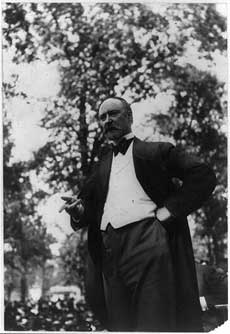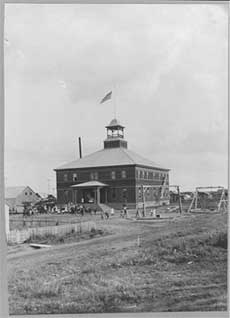 Fairbanks: Golden Heart City A story of its founding By June Allen July 13, 2004
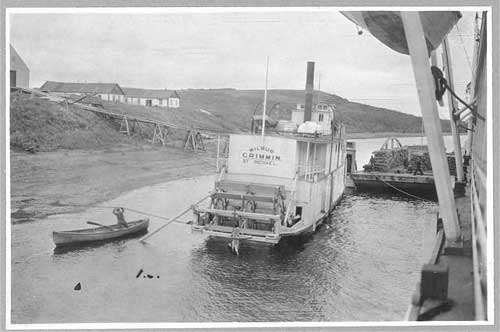 Forms part of: Frank and Frances Carpenter collection (Library of Congress). Gift; Mrs. W. Chapin Huntington; 1951. Courtesy Library of Congress Prints and Photographs Division Washington, D.C.
But Capt. Charles Adams found himself on the Chena River, a shallow channel getting narrower as it snaked along its lazy, monotonous course. A black spruce or two along the river's cutbanks that had toppled into the water during the spring's ice breakup swept the hull of the overloaded steamer as she labored upstream. There was increasing danger of grounding. Swarms of mosquitoes buzzed around Capt. Adams, whose patience was wearing thin with this unforeseen detour. 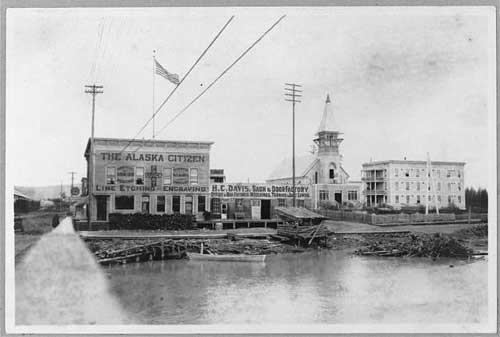 Forms part of: Frank and Frances Carpenter collection (Library of Congress). Gift; Mrs. W. Chapin Huntington; 1951. Courtesy Library of Congress Prints and Photographs Division Washington, D.C. In spite of a $6,000 contract with trader E. T. Barnette and the man's $20,000 cargo of general supplies and trading goods, Capt. Adams realized it would be impossible to continue this planned voyage up the Tanana to Tanacross, still hundreds of miles upstream. It was already late August. The glossy summer green of motionless birch leaves could turn autumn yellow overnight at this latitude 64 degrees 50 N and plunging temperatures would not be far behind. The captain had made up his mind. In spite of a reportedly hour-long argument with Barnette, and in spite of Mrs. Barnette's tears, the ship's log would record that at 4 p.m. August 26, 1901, the entire cargo of foodstuffs, tools and merchandise, Mr. Elbridge Truman Barnette, his weeping wife, his partner Charles Smith and three other men - one of whom may have been Frank Cleary, Barnette's brother-in-law - plus a horse and a dog team were offloaded on the spot. Deckhand Angus McDougall and Barnette's entourage reportedly cleared a few trees and made a clearing to cache the goods and peg-in tents for the rains sure to come. The captain sounded the ship's whistle as it headed downstream, the vessel riding higher and lighter. 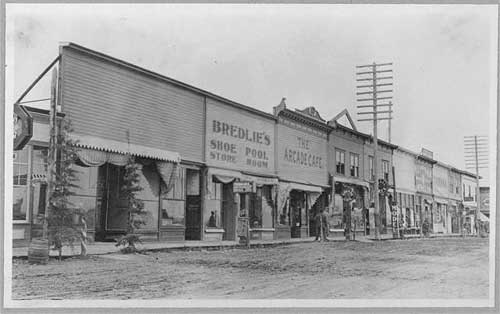 The precise location of that historic landing is said to be the present location of today's First and Cushman Streets in Fairbanks. But at that time it was just a raw clearing in the uninhabited middle of nowhere, on the wooded southern bank of a sluggish narrow river. Contemporary accounts present few other details of this legendary arrival of Fairbanks' founder, except for one other fact. In that summer of 1901, there were at least two other human beings in the nearby hills a few miles to the north and east of this new city-center-to-be. Their names were Felix Pedro and Tom Gilmore. Pedro sighted the Lavelle Young's smoke from their hilltop campsite. They had had been living on moose meat and berries as they prospected the creeks and rolling hills and were thrilled to discover that there were supplies available so near. The prospectors were Elbridge Truman Barnette's first customers, buying staples such as beans and bacon and flour. The Barnettes and company, their fate settled for the winter, snugged in to endure the long months until the ice-breakup of the rivers sometime the following May. Undaunted by his aborted beginnings, Barnette - well supplied and optimistic was confident of the future. The ambitious 37-year-old trader fully intended to find a way to get his goods east to Tanacross the next summer. Tanacross was the point at which the Interior's main trail met the Tanana River, with traffic enough to the warm the heart of any merchant. 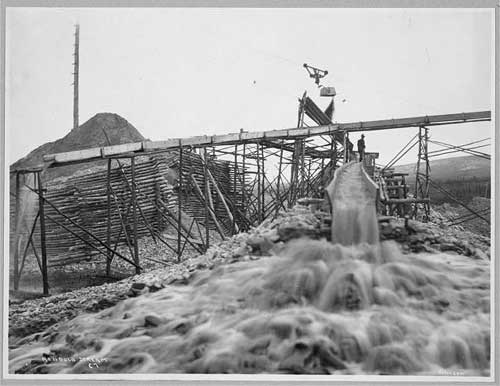 Photo by Johnson. Forms part of: Frank and Frances Carpenter collection (Library of Congress). Gift; Mrs. W. Chapin Huntington; 1951. Courtesy Library of Congress Prints and Photographs Division Washington, D.C.
The summer of 1902 finally arrived and Barnette was preparing to pack up and leave for Tanacross, but fate had a surprise in store for him. Those two prospectors, Felix Pedro and his partner Tom Gilmore, ran gasping and shouting into Barnette's encampment to announce that they had done it! They had struck it rich! They had staked out four claims in the hills twelve miles north of town! E.T. Barnette was quick to decide to stay put. He suddenly found himself the founder of a new town! He began work on a log cabin store which he called "the trading post." He also launched a PR campaign to get the news out and thus bring a stampede of workers and prospectors to his new town. 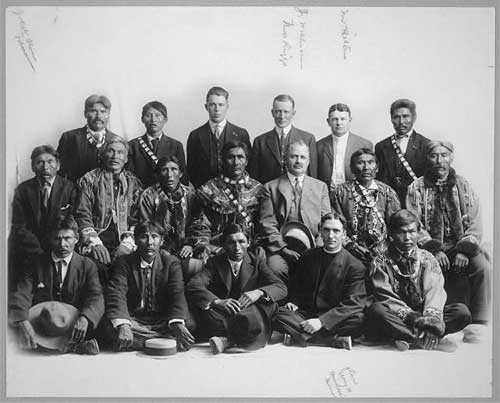
Wickersham encouraged Barnette to name the town Fairbanks, to honor one of the judge's acquaintances and someone he considered his mentor, Indiana Sen. Charles Fairbanks. The Senator was a loyal Republican who never seemed to curry favor with the GOP's party power brokers. He would finally be forced into what he considered the powerless, "do-nothing" position of vice-president under Pres. Teddy Roosevelt. And so, in his honor, was Fairbanks named, in 1903. The newly arrived judge immediately set himself up in business. As an entrepreneur, he wrote and published at least one limited edition of a newspaper, for which he charged $5 a copy and got it! His unpaid political appointment, like others in those days, required him to raise his own salary through fees and licenses, and this the judge set about doing. Lots in Fairbanks could be had for taking but required a filing fee of $2.50, to be paid to Wickersham. The judge was also available for various legal matters and other matters. Barnette's brother-in-law, Frank Cleary, drew a map and designed the sizes and locations of city blocks and lots. The judge's courthouse would be on Cushman Street between Second and Third Avenues. The exact center of the city was marked on the map, and at this point the gallows was built. (Today that spot is on the south side of what used to be the post office/ federal building, about a third of the way in from Cushman Street.) Fairbanks began to grow by leaps and bounds. Newcomers were arriving almost daily. Transportation had improved! The Valdez Trail, begin in 1898 from tidewater to points north, now reached far into the Interior. In December 1904 it was announced that a transportation company would soon provide passenger service to Fairbanks via horse-drawn bobsleds! The nine-day trip would cost $150. The old sourdoughs and early stampeders smiled and shook their heads, remembering uncounted miles of trudging along uncertain trails and through bogs or drifts with heavy packs on their backs! Now they could travel by bobsled? And then in 1906 Fairbanks the commercial district was devastated by a major fire, the town's first, but not its last, major disaster. According to one account, about 3 p.m. on May 22, 1906, a wisp of smoke curled out of a second story window of a building on the corner of First Avenue and Cushman Street. The story was told later that it had started in a dentist's office, where a wispy curtain at an open window had been blown across the flame of one of the dentist's tools and exploded throughout the building. In four hours, a newspaper account states, "the heart of town was a black and level waste." Gone were four full blocks from First to Third and from Turner to Lacey Streets. Lost were two banks, two newspapers, eight saloons, four clothing stores, the federal jail, and several hotels and restaurants. Rebuilding began immediately. Gold mining went on without pause throughout the city's travails. The actual mining activity was in a cluster of mines a dozen or more miles from Fairbanks. Satellite communities surrounded the diggings, so a railroad line from Fairbanks was built to provide transportation to and fro. These little towns boasted branches of Fairbanks' businesses as well as their own saloons and certain other establishments of ill repute. The mine town of
Then in 1907 the bottom fell out of the national economy as the mining market collapsed. Many people remembered the devastation of the major 1893 Depression that had taken until the turn of the 20th century to show recovery. The new city of Fairbanks had its first chance to demonstrate the grit and determination that that it would need to wait out recovery from the blow. Most were willing to wait it out. The economy revived but the boom days were gone. After ten years, the Gold Rush of '98 had finally faded. But a public school had been built in Fairbanks in 1907. Men had brought their wives and children north, and the city had become a family town. Except for the abundance of saloons, Fairbanks might have appeared to be Anywhere, U.S.A.. Regular church services were held. Trim log cabins and neat clapboard houses with tidy gardens gave Fairbanks a comfortable and settled appearance. E.T. Barnette prospered over the decade he had been the lead character in the story of the founding of Fairbanks, Alaska. To his trading post, which he later sold to the Northern Commercial Co., Barnette added other business ventures and interests. His crowning enterprise was the Washington-Alaska Bank. Whether his bank failed of its own weight or whether Barnette absconded with the funds is still debated. In 1911 the town was startled by the news that the bank had failed, and $11 million had vanished. Barnette and Isabel had slipped out of town. It was many years later that word filtered back that the Barnettes were living on a ranch in Mexico. The mystery of that bank crash and Barnette's disappearance is part of the city's dark past. The years of the 20th Century flew by. There was a world war, and then a railroad came to town, and a grand university was built! Aviation altered the old town once again. Everything changed and after a second world war, the small town became a big city. The one thing that remained constant was the spirit and zest of Fairbanks, its determination to survive and prosper and maybe the memory of the saints and sinners who built it.
june@sitnews.org
All rights reserved. Not to be reprinted in any form without the written permission of June Allen.
|
